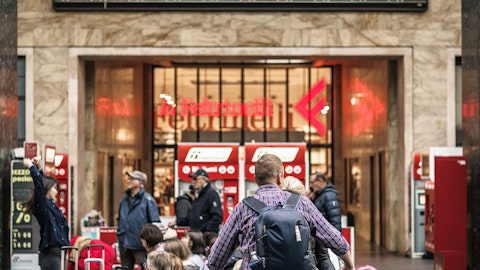Melanie Hart: Yeah. So, overall, for capital allocation, as we mentioned for the bulk of the year, we would really be looking at share repurchases opportunistically. Certainly, historically, we would expect that this year fourth quarter would continue to be a positive cash flow quarter and so we would have even more cash to spend that we currently have and when you look at just our total capacity on all of our debt arrangements, we have a significant amount of capacity. So really, we are very fortunate from a positioning standpoint that we have the ability to make decisions throughout the quarter to invest in what makes sense whether it be anything related to acquisitions, new sales center openings or continued share buybacks.
Susan Maklari: Okay. Thank you for all the color and good luck.
Peter Arvan: Thank you.
Operator: Our next question comes from David Manthey with Baird. Please go ahead.
David Manthey: Hi. Thank you. Good morning.
Peter Arvan: Good morning.
David Manthey: Is it fair to say that you have now lapped any strangeness or variability in the minor repair and maintenance volume situation, I mean, we had shortages, we had coded pull forward. Just trying to gauge if there’s any puts or takes remaining that would lead you to believe that MR — minor repair and maintenance business wouldn’t return to a typical kind of low single-digit growth rate next year? And I am not asking you for guidance, I am just saying is there anything in the past that would lead to variability as we look forward?
Peter Arvan: Yeah. No. I think that’s a fair question, Dave. I think the maintenance business should be normal. The only thing that I would tell you, impacted — we started to see an impact in the fourth quarter that carried a little over into first quarter from a maintenance perspective is the storm in Southwest Florida, but relatively minor from the total company perspective. But when I look at normal demand patterns for everything, I would tell you the maintenance and repair business has the highest predictability and stability, where it gets a little bit subjective is when it comes down to a repair versus an upgrade. So, and again, it really kind of depends on the market that you are talking about. In some cases, repairs may be choice number one.
In other cases, repair and replace or replace would be choice number one. But by and large, I don’t really see much different. In fact, I look at it and say that there’s — as I mentioned in my comments, there’s 70,000 new pools that are in the ground that have to be maintained next year that didn’t exist this year. There was likely some things that were put off this year that next year are going to have to be done. So the good news about a swimming pool in the market is there are certain things that I have to do every week, as you know, as a pool owner. There are some things that I could defer, but you can only defer things for so long when they turn into I’d like to a must have. So that part of the market, we remain confident in.
David Manthey: Right. Okay. Yeah. Don’t I know it. And then second, Melanie…
Peter Arvan: Yeah.
David Manthey: … does the inventory reduction effort in the back half of this year have any implications at all for the pre-buy, and therefore, your gross margin next year?
Melanie Hart: Yeah. Well, it certainly was able to allow us to clear out physical space or pre-buys and make the determination really on a vendor-by-vendor basis, depending upon what their individual incentives were of what we wanted to participate in. And so, I would say, if you had to characterize it compared to 2019, we would say that early buying season was relatively normal and so when you look at what that benefit that might bring for margin for next year, certainly, we will have better color on that once we take a look at what we have received kind of first quarter. We typically will receive early buys either in fourth quarter or first quarter. So we will have a better sense for that when we talk again in February. So the one thing that we did mention that will be slightly ahead of where it has been historically is typically, we would be looking at those kind of one to two price increases in the pre-2019 period, and so for next year, we are looking at those being slightly higher at kind of the 2% to 3% range.





